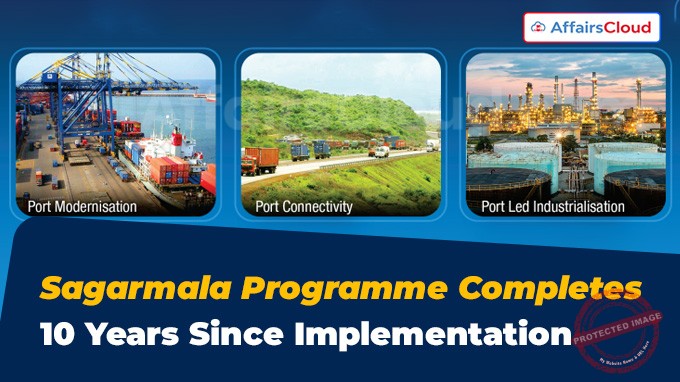 The Sagarmala Programme, a flagship initiative of the Ministry of Ports, Shipping and Waterways (MoPSW), launched in March 2015, has completed 10 years of successful implementation.
The Sagarmala Programme, a flagship initiative of the Ministry of Ports, Shipping and Waterways (MoPSW), launched in March 2015, has completed 10 years of successful implementation.
- The programme aims to revolutionalize port-led development in the country through harnessing India’s 7,500 kilometer (km) long coastline, 14,500 km of potentially navigable waterways and strategic location on key international maritime trade routes.
About Sagarmala Programme:
i.The Sagarmala Programme is a key part of the Maritime Amrit Kaal Vision 2047 (MAKV), which aims to make as a global leader in maritime affairs.
ii.MAKV which is developed on the basis of Maritime India Vision 2030 has set the ambitious targets like: 4 million Gross Tonnage (GT) of shipbuilding capacity and 10 billion metric tons (MT) of port handling annually.
- It also aims to make India one of the world’s top 5 shipbuilding nations by 2047.
iii.The total projects under the Sagarmala Programme are classified into 5 pillars and 24 categories:
- Pillar-I (Port-led Industrialization): It comprises 5 different categories such as: industrial cluster, Special Economic Zone (SEZ), thermal power, plants, port led industries.
- Pillar-II (Coastal Community Development): It includes 5 different categories such as: skill development, fisheries, ropeway, technology, centers, and community development.
- Pillar-III (Coastal Shipping & IWT): It comprises 6 different categories such as: coastal tourism, Ro-Ro/Ro-Pax/Passenger Jetty, cruise tourism, coastal infrastructure, island development, and Inland Waterways Transport(IWT)
- Pillar-IV (Port Modernization): It comprises 4 different categories such as: new ports, port modernization (major ports), port modernization (excluding major ports), and ship repairs.
- Pillar-V (Port Connectivity): It comprises 4 different categories such as: road, rail, pipeline, multi-modal hubs.
Key Objectives:
i.To mitigate logistics cost for EXIM (Export-Import) and domestic trade with minimal infrastructure investment.
ii.To improve local waterways (inland and coastal) in the multi-modal transport.
iii.To reduce logistics costs of bulk commodities by locating industries near to the coast.
iv.To generate jobs and develop skills in ports and maritime sector.
Status of Sagarmala Programme:
i.Under Sagarmala Programme, nearly 839 projects which are estimated to cost around Rs 5.79 lakh crores, have been identified for implementation.
- All these projects are implemented by central ministries, Inland Waterways Authority of India (IWAI), Indian Railways(IR), National Highway Authority of India (NHAI), state governments, major ports and other relevant organisations.
ii.As of March 19 2025, 272 projects have been completed, with total investment of around Rs 1.41 lakh crores.
iii.The Government of India (GoI) has allocated Rs 10,000 crore for 119 projects across coastal states and Union Territories (UTs).
iv.Under modernization pillar, 103 projects have been completed which resulted into port capacity addition for over 528 Million Tonnes Per Annum (MTPA).
v.Total 279 projects worth Rs 2.06 lakh are being implemented under port-connectivity pillar, with 92 projects completed.
vi.More than 300 projects worth Rs 26,000 crore under Community Development and Inland Waterways have benefitted 30,000 fishermen and coastal infrastructure.
vii.Total 14 projects worth Rs 55,000 crore have been allocated under Port-led industrialization, of which 9 are completed.
Key Accomplishments of Sagarmala Programme:
i.Coastal shipping has witnessed 118% growth over the last 10 years, which helps in reducing logistics costs and emissions.
ii.Inland waterway cargo movement saw an exponential growth of 700%, easing congestion on roads and railways.
iii.Over 40 lakh passengers benefitted from Ro-Pax ferries, improving coastal connectivity.
iv.Among the world’s top 100 ports, 9 are Indian ports, with Visakhapatnam Port featured in the list of world’s top 20 container ports.
v.More than 80 port connectivity projects valued at nearly Rs 52,000 crore have improved 1,500 km of connectivity to ports.
Funding Structure:
The funding structure of the programme includes 4 components such as:
i.Public-Private Partnership (PPP): This component gives preference to private sector participation, with PPP models implemented wherever possible.
ii.Internal and Extra Budgetary Resources (IEBR): Various projects receives financial assistance through the internal resources of MoPSW agencies, including major ports.
iii.Grant-in-Aid: Projects with high social impact but low financial returns receives partial funding under the Sagarmala Programme. This includes fishing harbours, coastal skill development, port modernization, among others.
iv.Equity: Sagarmala Development Company Limited (SDCL) was established in 2016 as part of the institutional framework under the Sagarmala Programme, to support project Special Purpose Vehicles (SPVs) formed by the central ministries, state governments, ports, and state maritime boards through equity participation.
About Sagarmala Startup Innovation Initiative (S2I2):
i.It is a transformative initiative launched in March 2025 by the Union Minister Sarbanda Sonowal, MoSPW, to promote innovation and entrepreneurship in India’s maritime sector.
iii.This initiative supports startups in various sectors such as: green shipping, smart ports, maritime logistics, shipbuilding technology, and sustainable coastal development, by facilitating funding, mentorship, and industry partnerships.
About Sagarmala 2.0:
i.In order to boost the Sagarmala Programme, the GoI is planning to launch Sagarmala 2.0 with a budget allocation of Rs.40,000 crore.
ii.The initiative is set to attract Rs.12 lakh crore in investments over the next decade, which will boost infrastructure development, coastal economic growth, and job creation.
About Ministry of Ports, Shipping & Waterways (MoPSW):
Union Minister- Sarbananda Sonowal (Constituency- Dibrugarh, Assam)
Minister of State (MoS)- Shantanu Thakur (Constituency- Bangaon, West Bengal, WB)




